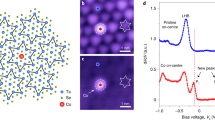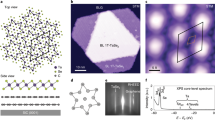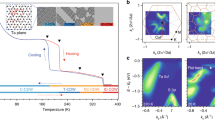Abstract
Two-dimensional triangular-lattice antiferromagnets are predicted under some conditions to exhibit a quantum spin liquid ground state with no energy barrier to create emergent, fractionalized spinon excitations that carry spin but no charge. Materials that realize this kind of spin liquid are expected to have a low-energy behaviour described by a spinon Fermi surface. Directly imaging the resulting spinons, however, is difficult due to their chargeless nature. Here we use scanning tunnelling spectroscopy to image density waves consistent with the predictions of spinon density modulation arising from a spinon Fermi surface instability in single-layer 1T-TaSe2. We confirm the existence of a triangular lattice of localized spins in this material by contacting it with a metallic 1H-TaSe2 substrate and measuring the Kondo effect. Spectroscopic imaging of isolated single-layer 1T-TaSe2 reveals long-wavelength super-modulations at Hubbard band energies, consistent with the predicted behaviour of itinerant spinons. These super-modulations allow the direct experimental measurement of the spinon Fermi wavevector, in good agreement with theoretical predictions for a two-dimensional quantum spin liquid.
This is a preview of subscription content, access via your institution
Access options
Access Nature and 54 other Nature Portfolio journals
Get Nature+, our best-value online-access subscription
$29.99 / 30 days
cancel any time
Subscribe to this journal
Receive 12 print issues and online access
$209.00 per year
only $17.42 per issue
Buy this article
- Purchase on Springer Link
- Instant access to full article PDF
Prices may be subject to local taxes which are calculated during checkout





Similar content being viewed by others
Data availability
Source data are provided with this paper. All other data that support the findings of this study are available from the corresponding author upon reasonable request.
Code availability
The codes used in this study are available from the corresponding author upon reasonable request.
References
Anderson, P. W. Resonating valence bonds: a new kind of insulator? Mater. Res. Bull. 8, 153–160 (1973).
Lee, P. A. An end to the drought of quantum spin liquids. Science 321, 1306–1307 (2008).
Balents, L. Spin liquids in frustrated magnets. Nature 464, 199–208 (2010).
Zhou, Y., Kanoda, K. & Ng, T.-K. Quantum spin liquid states. Rev. Mod. Phys. 89, 025003 (2017).
Wen, X.-G. Quantum orders and symmetric spin liquids. Phys. Rev. B 65, 165113 (2002).
Anderson, P. W. The resonating valence bond state in La2CuO4 and superconductivity. Science 235, 1196–1198 (1987).
Lee, P. A. From high temperature superconductivity to quantum spin liquid: progress in strong correlation physics. Rep. Prog. Phys. 71, 012501 (2008).
Shimizu, Y., Miyagawa, K., Kanoda, K., Maesato, M. & Saito, G. Spin liquid state in an organic Mott insulator with a triangular lattice. Phys. Rev. Lett. 91, 107001 (2003).
Yamashita, M. et al. Highly mobile gapless excitations in a two-dimensional candidate quantum spin liquid. Science 328, 1246–1248 (2010).
Shen, Y. et al. Evidence for a spinon Fermi surface in a triangular-lattice quantum-spin-liquid candidate. Nature 540, 559–562 (2016).
Motrunich, O. I. Variational study of triangular lattice spin-1/2 model with ring exchanges and spin liquid state in κ-(ET)2Cu2(CN)3. Phys. Rev. B 72, 045105 (2005).
Lee, S. S. & Lee, P. A. U(1) gauge theory of the Hubbard model: spin liquid states and possible application to κ-(BEDT-TTF)2Cu2(CN)3. Phys. Rev. Lett. 95, 036403 (2005).
Lee, S. S., Lee, P. A. & Senthil, T. Amperean pairing instability in the U(1) spin liquid state with Fermi surface and application to κ-(BEDT-TTF)2Cu2(CN)3. Phys. Rev. Lett. 98, 067006 (2007).
Mross, D. F. & Senthil, T. Charge Friedel oscillations in a Mott insulator. Phys. Rev. B 84, 041102(R) (2011).
Law, K. T. & Lee, P. A. 1T-TaS2 as a quantum spin liquid. Proc. Natl Acad. Sci. USA 114, 6996–7000 (2017).
He, W. Y., Xu, X. Y., Chen, G., Law, K. T. & Lee, P. A. Spinon Fermi surface in a cluster Mott insulator model on a triangular lattice and possible application to 1T-TaS2. Phys. Rev. Lett. 121, 046401 (2018).
Klanjšek, M. et al. A high-temperature quantum spin liquid with polaron spins. Nat. Phys. 13, 1130–1134 (2017).
Kratochvilova, M. et al. The low-temperature highly correlated quantum phase in the charge-density-wave 1T-TaS2 compound. npj Quantum Mater. 2, 42 (2017).
Ribak, A. et al. Gapless excitations in the ground state of 1T-TaS2. Phys. Rev. B 96, 195131 (2017).
Yu, Y. J. et al. Heat transport study of the spin liquid candidate 1T-TaS2. Phys. Rev. B 96, 081111(R) (2017).
Murayama, H. et al. Effect of quenched disorder on the quantum spin liquid state of the triangular-lattice antiferromagnet 1T-TaS2. Phys. Rev. Res. 2, 013099 (2020).
Wilson, J. A., Di Salvo, F. J. & Mahajan, S. Charge-density waves and superlattices in the metallic layered transition metal dichalcogenides. Adv. Phys. 24, 117–201 (1975).
Fazekas, P. & Tosatti, E. Electrical, structural and magnetic properties of pure and doped 1T-TaS2. Phil. Mag. B 39, 229–244 (1979).
Qiao, S. et al. Mottness collapse in 1T-TaS2–xSex transition-metal dichalcogenide: an interplay between localized and itinerant orbitals. Phys. Rev. X 7, 041054 (2017).
Ritschel, T. et al. Orbital textures and charge density waves in transition metal dichalcogenides. Nat. Phys. 11, 328–331 (2015).
Ma, L. et al. A metallic mosaic phase and the origin of Mott-insulating state in 1T-TaS2. Nat. Commun. 7, 10956 (2016).
Cho, D. et al. Nanoscale manipulation of the Mott insulating state coupled to charge order in 1T-TaS2. Nat. Commun. 7, 10453 (2016).
Nakata, Y. et al. Selective fabrication of Mott-insulating and metallic monolayer TaSe2. ACS Appl. Nano Mater. 1, 1456–1460 (2018).
Chen, Y. et al. Strong correlations and orbital texture in single-layer 1T-TaSe2. Nat. Phys. 16, 218–224 (2020).
Kim, B. J. et al. Distinct spinon and holon dispersions in photoemission spectral functions from one-dimensional SrCuO2. Nat. Phys. 2, 397–401 (2006).
Ryu, H. et al. Persistent charge-density-wave order in single-layer TaSe2. Nano Lett. 18, 689–694 (2018).
Cai, P. et al. Visualizing the evolution from the Mott insulator to a charge-ordered insulator in lightly doped cuprates. Nat. Phys. 12, 1047–1051 (2016).
Ruan, W. et al. Relationship between the parent charge transfer gap and maximum transition temperature in cuprates. Sci. Bull. 61, 1826–1832 (2016).
Battisti, I. et al. Universality of pseudogap and emergent order in lightly doped Mott insulators. Nat. Phys. 13, 21–25 (2017).
Ruan, W. et al. Visualization of the periodic modulation of Cooper pairing in a cuprate superconductor. Nat. Phys. 14, 1178–1182 (2018).
Hewson, A. C. The Kondo Problem to Heavy Fermions (Cambridge Univ. Press, 1993).
Nagaoka, K., Jamneala, T., Grobis, M. & Crommie, M. F. Temperature dependence of a single Kondo impurity. Phys. Rev. Lett. 88, 077205 (2002).
Helmes, R. W., Costi, T. A. & Rosch, A. Kondo proximity effect: how does a metal penetrate into a Mott insulator? Phys. Rev. Lett. 101, 066802 (2008).
Madhavan, V. V., Chen, W., Jamneala, T., Crommie, M. F. & Wingreen, N. S. Tunneling into a single magnetic atom: spectroscopic evidence of the Kondo resonance. Science 280, 567–569 (1998).
Ge, Y. & Liu, A. Y. First-principles investigation of the charge-density-wave instability in 1T-TaSe2. Phys. Rev. B 82, 155133 (2010).
Galitski, V. & Kim, Y. B. Spin-triplet pairing instability of the spinon Fermi surface in a U(1) spin liquid. Phys. Rev. Lett. 99, 266403 (2007).
Grover, T., Trivedi, N., Senthil, T. & Lee, P. A. Weak Mott insulators on the triangular lattice: possibility of a gapless nematic quantum spin liquid. Phys. Rev. B 81, 245121 (2010).
Xu, X. Y., Law, K. T. & Lee, P. A. Pair density wave in the doped t−J model with ring exchange on a triangular lattice. Phys. Rev. Lett. 122, 167001 (2019).
Agterberg, D. F. & Tsunetsugu, H. Dislocations and vortices in pair-density-wave superconductors. Nat. Phys. 4, 639–642 (2008).
Fradkin, E., Kivelson, S. A. & Tranquada, J. M. Colloquium: theory of intertwined orders in high temperature superconductors. Rev. Mod. Phys. 87, 457–482 (2015).
Tang, E., Fisher, M. P. A. & Lee, P. A. Low-energy behavior of spin-liquid electron spectral functions. Phys. Rev. B 87, 045119 (2013).
Edkins, S. D. et al. Magnetic field–induced pair density wave state in the cuprate vortex halo. Science 364, 976–980 (2019).
Huse, D. A. & Elser, V. V. Simple variational wave functions for two-dimensional Heisenberg spin-1/2 antiferromagnets. Phys. Rev. Lett. 60, 2531–2534 (1988).
Ribeiro, P. & Lee, P. A. Magnetic impurity in a U(1) spin liquid with a spinon Fermi surface. Phys. Rev. B 83, 235119 (2011).
Norman, M. R. & Micklitz, T. How to measure a spinon Fermi surface. Phys. Rev. Lett. 102, 067204 (2009).
Acknowledgements
We thank D.-H. Lee, J. E. Moore and M. Zaletel for helpful discussions. This research was supported by the vdW Heterostructure program (KCWF16) (STM/STS measurements) and the Advanced Light Source (sample growth and ARPES measurements) funded by the Director, Office of Science, Office of Basic Energy Sciences, Materials Sciences and Engineering Division, US Department of Energy (DOE), under contract no. DE-AC02-05CH11231. Support was also provided by the National Science Foundation (NSF) via award no. DMR-1807233 (surface treatment and topographic characterization) and award no. DMR-1926004 (theoretical QPI analysis). Computational resources were provided by the NSF through the Extreme Science and Engineering Discovery Environment (XSEDE) resources. The work at the Stanford Institute for Materials and Energy Sciences and Stanford University (ARPES measurements) was supported by the Office of Basic Energy Sciences, Materials Sciences and Engineering Division, DOE. The work at Beamline 4-ID-D of the Advanced Photon Source, Argonne National Laboratory (X-ray absorption measurements), was supported by the Office of Science, Office of Basic Energy Sciences, DOE, under contract no. DE-AC02-06CH11357. P.A.L. acknowledges support by DOE Basic Energy Science award no. DE-FG02-03ER46076 (theoretical QSL analysis). S.T. acknowledges support by CPSF-CAS Joint Foundation for Excellent Postdoctoral Fellows. J.H. and C.H. acknowledge fellowship support from the NRF grant funded by the Korean government (MSIT) (no. 2021R1A2C1004266). H.-Z.T. acknowledges fellowship support from the Shenzhen Peacock Plan (grant nos. 827-000113, KQJSCX20170727100802505 and KQTD2016053112042971).
Author information
Authors and Affiliations
Contributions
W.R., Y. Chen, P.A.L. and M.F.C. initiated and conceived this project. W.R., Y. Chen, R.L.L., H.-Z.T., S.K., F.L., C.J. and A.A. carried out the STM/STS measurements under the supervision of M.F.C. W.R., Y. Chen, F.W., P.A.L. and M.F.C. contributed to the microscopy data analysis. S.T., J.H. and H.R. performed the sample growth and ARPES measurements/analysis under the supervision of C.H., Z.-X.S. and S.-K.M. W.R., Y. Chen, R.L.L. and S.K. performed the XMCD measurements with support from Y. Choi. M.W. performed the DFT+U calculations under the supervision of S.G.L. P.A.L. provided theoretical support. W.R., Y. Chen and M.F.C. wrote the manuscript with the help from all the authors. All the authors contributed to the scientific discussion.
Corresponding author
Ethics declarations
Competing interests
The authors declare no competing interests.
Additional information
Peer review information Nature Physics thanks the anonymous reviewer(s) for their contribution to the peer review of this work.
Publisher’s note Springer Nature remains neutral with regard to jurisdictional claims in published maps and institutional affiliations.
Supplementary information
Supplementary Information
Supplementary Notes 1–4 and Figs. 1–16.
Source data
Source Data Fig. 1
Images.
Source Data Fig. 2
Raw data for the plots.
Source Data Fig. 3
Images and raw data for the plots.
Source Data Fig. 4
Raw data for the plots.
Source Data Fig. 5
Images.
Rights and permissions
About this article
Cite this article
Ruan, W., Chen, Y., Tang, S. et al. Evidence for quantum spin liquid behaviour in single-layer 1T-TaSe2 from scanning tunnelling microscopy. Nat. Phys. 17, 1154–1161 (2021). https://doi.org/10.1038/s41567-021-01321-0
Received:
Accepted:
Published:
Issue Date:
DOI: https://doi.org/10.1038/s41567-021-01321-0
This article is cited by
-
Controlling structure and interfacial interaction of monolayer TaSe2 on bilayer graphene
Nano Convergence (2024)
-
Machine learning reveals features of spinon Fermi surface
Communications Physics (2024)
-
Charge-density wave mediated quasi-one-dimensional Kondo lattice in stripe-phase monolayer 1T-NbSe2
Nature Communications (2024)
-
Heavy fermions vs doped Mott physics in heterogeneous Ta-dichalcogenide bilayers
Nature Communications (2024)
-
Quantum spin liquid signatures in monolayer 1T-NbSe2
Nature Communications (2024)



